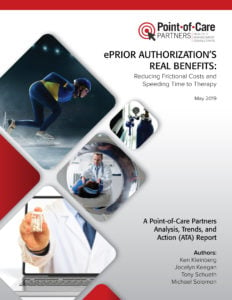By Ken Kleinberg, Practice Lead, Innovative Technologies
 Ken Kleinberg, Practice Lead
Ken Kleinberg, Practice Lead
CAQH’s (Council for Affordable Quality Healthcare) recently released their new Phase V CORE Operating Rules for prior authorization (PA) that improve on specificity needed to advance ePrior Authorization (ePA). Coming from the primary organization tasked with tracking and adoption of healthcare transactions, this is a timely release given the high attention being paid to PAs, especially considering recent pushback from the AMA.[1]
As we analyzed in our major report on ePA, there are many challenges the industry is facing, with lack of comprehensive-enough standards and poor adoption by payers and providers being two of the largest. While the X12 278 HIPAA transaction for PA has been in use for many years, its adoption has been disappointing (about 12 percent as per the CAQH Index) – and largely over-shadowed by NCPDP standards for drugs under the pharmacy benefit (even without formal sanction). The 278 is also considered generally inadequate for handling complex aspects of drugs, devices, services, and procedures under the medical benefit. CAQH is aware of this and is doing its part to solidifying its core functions in parallel and conjunction with the development of new and complementary approaches from others in such areas as attachments, APIs and use cases. Let’s examine this.
To review, although the 278 is the federally mandated HIPAA standard for PA for providers and payers, it does not allow for attachments that include the clinical detail often required for resolution. Therefore, use of other transactions, or out-of-transaction exchange of details must occur. In addition, many EHR vendors don’t support the 278 from within clinician workflow (or may charge a premium for it), and many payer’s portals (or those of their agents or intermediaries) don’t accept it or make variable, or poor use of it. The result: about half the PA requests by providers for medical benefit are submitted manually, usually via phone and fax, in spite of long hold times and delays (ironically, often providing more clarity than limited transactions). This contrasts with several more back-office focused HIPAA transactions routinely used effectively for eligibility and benefits verification, claims and claims status, claim payment and remittance, etc., where CAQH reports adoption at 48-96 percent.
A major driver for CAQH action is to address concerns and recommendations by the National Committee on Vital and Health Statistics (NCVHS), advisors to the Secretary of Health and Human Services (HHS), as to why 278 adoption has stalled and its need to keep up with the needs of value-based payment models. CAQH also conducts its own surveys, results of which show a need to focus on data content and workflow, along with format, transport, and utilities. Providers, in particular, complain that receiving a pending status back does little to help them understand if there is more information to send, how much longer they will need to wait, or format of payer response (e.g., letter, portal notification, or phone).
For these Phase V rules, CAQH analyzed input from 100 entities comprised of providers, health plans, vendors, and the government to identify 20 levels of improvement to advance the 278 as a direct transaction from provider workflow to payer, and through web portals (about 1/3 of PA requests go this route, though it requires logging into different systems and rekeying). This progress is encouraging, although there is still much to be done, such as issues around stakeholder wait time for a response or required special handling of emergency/urgent requests.
Most notably, these new rules did not focus on attachment standards, which CAQH noted as being addressed by pending federal regulations and would therefore be handled with future CAQH rules. CAQH also considers retail pharmacy ePA and the pharmacy benefit as the purview of NCPDP. As discussed in our ePA report, a converged set of standards for pharmacy and medical benefit is really where the industry needs to head (some of the acquisitions we’re seeing with payers and PBMs are indicative of this).
Where CAQH has focused, there is much benefit to be gained – specifically with core capabilities that any more comprehensive and transformational solution will still need to rely on. The advances were described in two rule sets with the Data Content Rule focused mainly on closing gaps of missing or incorrect information regarding medical necessity checking, and the web portal rule addressing the better mapping of data collected from a portal to adherence with the PA transaction. Improvements included:
278 Request / Response Data Content Rule
- Better patient identifying and verification information to reduce common errors and associated denials, including name normalization (e.g., removal of character strings such as Jr, PHD, ESQ), punctuation, dates, and special characters processing as dependent on the various loops and segments
- More specific AAA error and action codes and related code descriptions to reduce burden of interpretation and resolving pending submissions through more specifics as to what is wrong (e.g., out of network provider) or what is required – e.g., LOINC (Logical Observation Identifier and Codes), PWK01 Attachment Report Type Codes, and Health Care Service Decision Reasons Codes (HCSDRC)
Prior Authorization Web Portal Rule
- Better uniformity in data field labels (e.g., Technical Report Type 3 [TR3] implementation names and alias names)
- System availability to receive requests to improve predictability of response (no less than 86 percent availability per calendar week – or max of 24 hours of regularly scheduled downtime, with a week of advance notice)
- Confirmation of receipt from a web submission (with next steps)
For these latest improvements in operating rules to have the highest benefit on PA adoption, they need to be supplemented with advances in other key areas. This includes addressing the major burden for providers of not knowing if a PA is required or not, and in the difficult process of obtaining and transferring the necessary evidence to payers in a form they can readily review. For payers, it requires communicating the most up-to-date guidelines, rules, and formularies to providers, and then processing all the unstructured information often received from providers to arrive at a decision. CAQH is right that federal standards for exchanging clinical content are needed to reduce the variability inherent in the process today. Open API standards such as FHIR (Fast Healthcare Interoperability Resource) and initiatives like Da Vinci are advancing a number of use cases that will make a major difference. It’s comforting in reviewing these new rules to know that advances are being made in the core and underlying transactions and in minimum rules and requirements to reduce the infuriating challenges of communicating status and requests in such a key area as PA.
[1] https://www.ama-assn.org/practice-management/sustainability/1-4-doctors-say-prior-authorization-has-led-serious-adverse
Related Resources:
ePrior Authorization’s Real Benefits: Reducing Frictional Costs and Speeding Time to Therapy
 Point-of-Care Partners leveraged our unique perspective and relationships in the market with payers, providers, life sciences companies, and the stakeholders supporting them to create this new and comprehensive report. Our experts brought their extensive experience with ePA, ePrescribing, medication management, and transactions in support of value-based care together with industry interviews, in the writing of this report designed to bring your team up to speed on the ePA landscape with an in-depth analysis of what the future may hold.
Point-of-Care Partners leveraged our unique perspective and relationships in the market with payers, providers, life sciences companies, and the stakeholders supporting them to create this new and comprehensive report. Our experts brought their extensive experience with ePA, ePrescribing, medication management, and transactions in support of value-based care together with industry interviews, in the writing of this report designed to bring your team up to speed on the ePA landscape with an in-depth analysis of what the future may hold.
Download the Report Preview
Purchase the Report
Watch the Webinar Recording
Enhancing ePrior Authorization – Is Multi-Stakeholder Win-Win Possible?
Ken Kleinberg, May 14, 2019. CBI Real-Time Benefit Check & ePrior Authorization Summit




